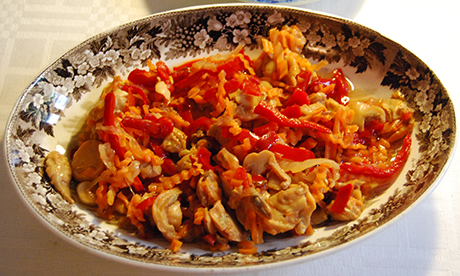Discovering the delights of the Polish deli: Gillian Riley on the pleasures of a hidden cuisine
Last month’s recipe for Chlodnik relies on the interplay of many ingredients, with astonishing visual impact; another national dish is equally complex, but with a dark almost muddy hue. Bigos, hunter’s stew, is festive food for cold winter days, a dish for heroes, made by heroines, toiling away for days on end.
A sumptuous French choucroûte garni is but a pale shadow of this amazing dish. A variety of cooked meats, from beef, mutton, sausage, lumps of boiled bacon, and game and fowl, from goose to pigeon, are layered with sauerkraut and finely sliced fresh cabbage, mushrooms, apples and prunes, with a multiplicity of seasonings, and cooked very slowly for several hours in a vast pot. Reheated it gets even better. You can buy portions of this ready-made, by artisan producers, or commercial versions in jars, in many Polish delis. Go for it.
Instead I do a medieval version, which does not rely on hunters’ skills or the toil of womenfolk. It’s from the fourteenth century, where it was on the menus of aristocratic and royal banquets, and has many of the delights of bigos, without the weight of expectations.
Recipe: Chicken with Prunes
1 good quality organic chicken,
jointed
Some strong broth made from
the carcass
1 large onion, peeled and sliced
1 cabbage, thinly sliced
30 prunes
15 juniper berries
chopped garlic to taste
1 stick of cinnamon
4 cloves
2 blades of mace
1 tsp caraway seeds
2 bay leaves
chopped dill
chopped parsley
dry white wine
salt to taste
Put the chopped onion on the bottom of a roasting pan, then the cabbage, prunes and juniper berries, bay leaves and spices; strew on the green herbs, place the chicken on top, skin side up, pour over some of the broth and wine, cover with foil, and bake in a moderate oven until tender – for about 45 minutes to one hour. Remove the foil and put back in the oven to brown gently, and reduce the liquid.
Polish food has subtleties and splendours that are worth the effort to winkle out. Pierogis are a wonderful version of the stuffed pasta or pastry that appears throughout Eastern Europe and beyond, from the tortelloni of Italy, to the fragrant filled dumplings of Sichuan. Polish delis in London sell industrial, frozen versions, or vacuum packed pierogis, and also artisan or home-made ones, plump, bulging cushions with voluptuous fillings of pork, cabbage, mushrooms, cheese and potatoes, in different combinations. These can be boiled for five to ten minutes, then served wallowing in butter in which some chopped onions have been lightly browned.
The world of Polish sausage is entrancing and versatile, from the many lightly smoked ones, which can be eaten cold, sliced or in chunks, or added to cooked dishes like bigos, to uncooked ones to boil, grill or fry. There’s a huge variety of flavours and textures, garlic of course, marjoram, caraway and juniper are the most recognisable, but the message from the kindly delis is buy a few links for a tasting, then come back for more.
Vegetables are pickled and preserved in mild and delicate ways, more like bottled salads than the harsh pickles we know. Those with mushrooms are particularly good.
Some say that Fish and Chips was the invention of the Polish/Jewish community in London. This medieval recipe is a plausible explanation for the presence of mushy peas with fried fish. The original version uses a special kind of Polish dried pea to thicken a sauce for fish, but I have deviated shamelessly in favour of a lighter, prettier, version, using frozen peas for a bright fresh green. When Sabina Welzer wrote in her kitchen notebooks in Augsburg in 1553 of a “Polish sauce for Pike” she was referring to ancient courtly traditions, using those dried yellow peas and millet flour to thicken the sauce. We don’t have to. So here is a deconstructed version which is very tasty. In Hackney we do not have easy access to the freshwater fish, so use a tasty firm fleshed fish like sea bass or halibut instead.
Recipe: Fish in a Green Sauce
1 wild sea bass, whole or fillets
2 cups of frozen peas
1 onion, chopped, softened in butter
fish broth
a cupful of light beer
a little honey to taste
1 clove of garlic, chopped
1 cup of chopped parsley
1 cup of chopped dill
2 or 3 green lettuce leaves
fresh ginger, crushed
2 blades of mace
salt to taste
Cook the peas in beer and fish broth until tender. Put them in a blender or liquidiser along with the onions, parsley, dill and lettuce, the ginger, garlic and mace, and whizz to a coarse purée. Add salt and honey to taste.
Bring to the boil. Lay the fish in an ovenproof dish, pour the sauce over and cook in a hot oven until just done, so that the fish flakes easily but is not dried out, for 20-30 minutes, depending on the thickness of the fish.
Related:
Polish grub puts Eastern European nation in pole position in food stakes

